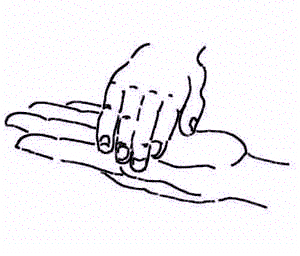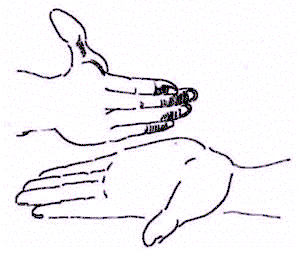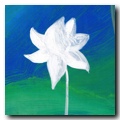
Off the beaten track yet more than a detour, and fun: with your own voice (even if quietly or just imagined) and hands.
In short, this set of exercises provides a bridge for anyone keen on combining both, traditional and unconventional learning opportunities; even if for no more than getting immersed or enjoying a break from daily routines, simply because
Music is the purest form of art when life is attuned to a single tune and a single time beat!
“Music is the purest form of art, and therefore the most direct expression of beauty, with a form and spirit which is one, and simple, and least encumbered with anything extraneous. … No one of its notes is final, yet each reflects the infinite.” – Rabindranath Tagore in Sadhana, the Realisation of Life
And for Mahatma Gandhi, “in its wider sense, true music is created only when life is attuned to a single tune and a single time beat. Music is born only where the strings of the heart are not out of tune.”
This “Flow exercise” can be practiced virtually anywhere, any time and even quietly while surrounded by a milling crowd.
Step 1: attune to your “inner tambura” for focus
Pronounce the following syllables whereby Capital syllables indicate twice the duration of those in lower case:
sa SA
pa PA
’sa ’SA
pa PA
sa sa pa pa
‘sa ‘SA
pa PA
sa SA
pa PA
‘sa ‘sa pa pa
Total:
16 units per block (4×3+4)
32 units for both blocks together
Adi tala has 32 units per cycle as demonstrated below.
Select a pitch that suits your natural voice from the following audio samples.
sa, SA, pa & PA = middle octave (madhya sthayi)
’sa & ’SA = higher octave (tara sthayi)
Audio | Sruti selection for different vocal ranges and ragas
Credit: eSWAR / FS-3C Sruthi petti + Tanjore Tambura
Once memorized, combine these simple patterns with traditional hand gestures as explained in the following step. Worth remembering: not so long ago, even lay listeners used to perform these very gestures during live concerts just as during broadcasts of their favourite musicians! Some still do, obviously without disturbing other listeners or the performing ensemble …
Step 2: combine it with hand gestures (Adi Tala)
Adi tala with 32 units (8×4 units per cycle) provides the foundation for Carnatic rhythm (laya) as practiced today: it is regarded as flexible, facilitates perfect alignment besides providing expert musicians with opportunities to display their arithmetic skills. | If interested, join a free mini course here >>
Exercises (4 talas)
First memorize these exercises in order to practice them anywhere, any time:
Ādi tāla (8 syllables) – Duration: 2:44
“ta ka dhi mi ta ka ju nu“- trikāla = 3 speeds
Misra cāpu tāla (7 syllables) – Duration: 2:52
“ta ki ta ta ka dhi mi” – trikāla = 3 speeds
Khanda cāpu tāla (5 syllables) – Duration: 2:05
“ta ka ta ki ta“- trikāla = 3 speeds
Rūpaka tāla (3 syllables) – Duration: 0:42
“ta ki ta“- trikāla = 3 speeds
Then
– add hand gestures and claps as indicated on the accompanying PDF-sheet
– count the units as indicated
Tips: for better retention, make sure to pronounce each syllable clearly; also practice silently (whenever required by circumstances)
Tips for larger groups to practice together
The following approach has proven to work particularly well with larger groups
Step 1 Practice together in a moderate tempo as follows:
– maintaining an equal tempo with hand gestures and claps (as transcribed on the PDF-sheet)
– counting the units
Step 2 Once participants have become confident, subdivide the group into three.
This allows you to assign each sub-group with one of the above tasks, accompanied by the other sub-groups before letting them take turns.
Step 3 Adapt the lessons to a creative process that suits your situation, within Carnatic music and beyond.
All of this works equally well with open-minded adult learners, however inexperienced.
Think of intercultural collaborations among performers and composers in search of a common ground, all based on actual music making rather than abstract ideas.
Visit Archive.org for more suggestions to learn how to practice, enjoy and share these and other exercises!
More about keeping tala with hand gestures
Keeping tala e.g. for Rupaka tala (3 counts): 2 claps followed by a wave; Adi tala (8 counts): a clap for the first beat (samam), followed by 3 finger counts starting from the small finger marks the first half; and a clap followed by a wave (twice) mark the second half; Ata tala (14 counts) differs as 4 fingers are used including the forefinger (twice), rather than 3 fingers (once) in Adi tala.
Art © Arun VC
Tips
- Practice these gestures “silently” during a live recital or recording
- Apply your practice while watching a video:
– Basic hand gestures for Adi tala (8 beats) & Misra chapu tala (7 beats)
– Precision tala keeping for the following drum and konakkol solo
For those remembering the 1970s and 1980s it may seem obvious that musical enjoyment is not meant to be a “passive” or “unidirectional” affair: then listener participation was the rule rather than the exception in Carnatic music circles; and All India Radio offered an inexhaustible source of musical delight on a daily basis. Whether for the sake of appreciation as rasika or with the aim of getting involved as learner by means of raga and laya: Carnatic music has always meant more to musicians and their audiences, thereby making it a truly unique heritage (bani, sampradaya): “The tempo, the voice, the volume, the mellifluousness, everything enters your body“; all thanks to …
… playful learning opportunities being so plentiful!
If there’s a misconception in what should be another “golden age” for Carnatic music – the digital age – it may be this: a sense of exclusion if not inferiority among music lovers as regards boundaries thats separate them from their “stars” their highly specialized mentors.
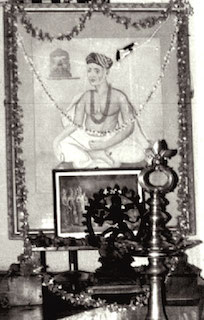
at Kalakshetra
Photo © Ludwig Pesch
Among the most creative personalities and dissidents in this regard was the singer and educator VV Sadagopan: at the peak of his career as singer and academic, his life’s mission became the creation of playful learning opportunities. In this manner, he felt that the joy of his chosen music could be conveyed to both, the young and the young at heart by what has become known as integrated music education.
There are no limits for anyone, even though Carnatic music may rightly be described as being “devotional”; for rarely (if ever!) it was the exclusive domain of any particular social group: even the “brilliant Semmangudi Srinivasa Iyer, who was himself deeply religious, clarified that bhakti is essential for a Carnatic music, but this bhakti is for music, not for any personal deity”. – Dr. Lakshmi Sreeram in “Carnatic Music Ruminating the Landscape”
Tradition and change: integrity matters, even in the digital age!
In this course, new exercises are introduced with due respect for integrity – respect for a music that has evolved over several centuries (in its present concert format) and far beyond (as regards thought provoking concepts that kindle long-term immersion).
Some of the exercises and methods facilitate continuous or frequent practice among learners who struggle with multiple commitments.
So this is all about the kind of active involvement in a tradition wherein music is simply indispensable for leading a fulfilled life. This also explains why long-term commitment is compatible with socio-economic and scientific change. This calls for imagination, a fact reflected in text books that highlight the importance of manodharma sangita, a concept reaching beyond “improvisation” as understood in Western music.
We may therefore safely conclude that both commitments, learning and teaching, are by no means determined by an individual’s station in life.
For this reason, lessons may either be shared regularly and personally (by a guru, in the past largely informally within a household known as gurukulam), or without personal contact by emulating an inspiring exponent – alive or otherwise (manasa guru, manasika guru). Many musical biographers and hagiographers share a conviction that a learner’s choice for either approach – personal or indirect lessons – tells little if anything about an accomplished musician’s status.
In short, this is all about dedication and integrity, even in the digital age!
And what about the “real tambura”?
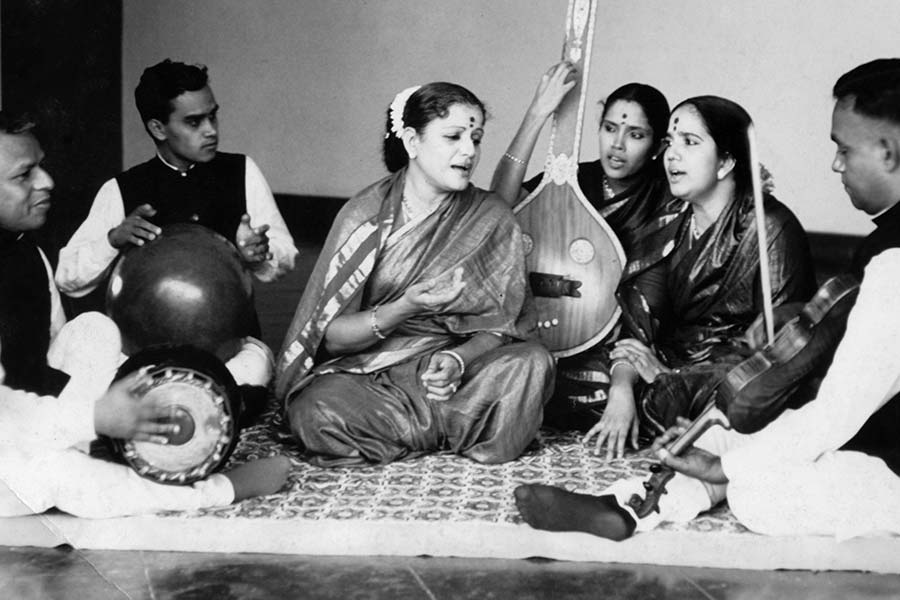
“Even at the peak of her career M.S.Subbulakshmi continued to
learn from other musicians” – R.K. Shriram Kumar >>
Tambura posture, fingering & therapeutic effect >>
The four strings of the tambura that provide sruthi or the basic swara (pitch) for musicians are considered the life force for any melodic exercise. Fixed in jack wood to enhance the naada, yesteryear musicians were stuck to this pitch provider because there were no alternatives. […]
While many are comfortable with the electronic gadget while practising, how does it feel to have an object there on the concert stage, bereft of human touch, minus the aesthetics of the real thing?
Ranjani Govind in The Hindu | Learn more: Musicians comment on the convenience and compromise of digital tanpura & “My music is an extension of my tambura” – Bombay Jayashri >>
Learn & practice more
A brief introduction to Carnatic music (with music examples and interactive map)
Bhava and Rasa explained by V. Premalatha
Free “flow” exercises on this website
Introduction (values in the light of modernity)
Video | Keeping tala with hand gestures: Adi (8 beats) & Misra chapu (7 beats)
Why Carnatic Music Matters More Than Ever
Worldcat.org book and journal search (including Open Access)
